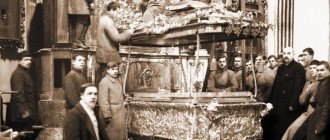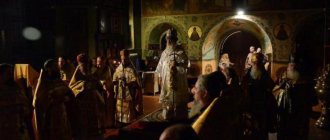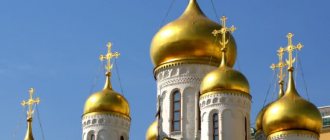The Russian Orthodox Church could not be split by the 300-year Tatar-Mongol yoke. No matter how hard they tried, the popes could not subjugate them to their throne. The Russian Church was led to a schism in the second half of the 17th century by its own Russian people - Tsar Alexei Mikhailovich, nicknamed the Quietest, and Patriarch Nikon. They introduced church reform with fire and sword.
Hundreds of thousands of believing Russian people were executed only because they did not want to put their fingers together during baptism with a “pinch”, because they prayed from old books, with true two-fingered fingers, did not recognize the new church reform and were devoted to the faith of their fathers. For this, their tongues were torn out and their hands were cut off so that they would not raise their two fingers in prayer, they were quartered, burned - like Archpriest Avvakum. But faith turned out to be more valuable to them than life.
The emergence and development of the Old Believers
There are several points of view on the emergence of the Old Believers, but they all fit into two general schemes. The first position belongs to the state church and secular historians of religion, philosophers, political scientists and religious scholars. Here the Old Believers appeared as a set of human wills opposing state and church policies and innovations that were destroying the traditional structure of Russian society. Events 1653–1667 disintegrated the foundations of Rus', turning church (and state as a source, naturally) policy in a different, Western direction.
But there is also a radically different version, it belongs to the Old Believers themselves. From the Old Believer point of view, Old Belief cannot be reduced to a cultural branch, a church movement, a sect, an anarchist movement, or fanatical love of Russolove. Those who led the people into the forests and tundras saw that the Orthodox Church had ceased in Rus', something else had come, masquerading as Orthodoxy, but not being it. The Old Believers considered themselves “zealots of piety”; they understood that Orthodoxy was preserved only among them - Christianity of ancient foundations, the Apostolic Church. For this reason, the real self-name of the Old Belief is “ANCIENT ORTHODOXY”. Following the semiotic concept of Mikhail Bakhtin , here we can highlight the aspect of identification of the Old Believers with the ancient Church, the connection of times and heritage. And the term “Old Believers” carries an erroneous idea of understanding the Old Orthodox Church, reducing its essence, as mentioned above, to schismaticism, opposition, and anti-statism.
However, there is a third ideological position that superficially reconciles both points of view. According to this concept, society in the second half of the 17th century was divided into two categories. The first believed the word of the patriarch and the orders of the sovereign unquestioningly, and she followed them, without considering the road. The second category of Orthodox believed the Gospel and Church Tradition to be a higher power than everyone who even preached this Tradition, this Gospel.
Thus, modern postmodern society, in understanding the essence of the Old Believers and its history, offers (or rather, accepts, according to the concept of “challenge-response” by A. J. Toynbee) several concepts, different, but quite reconcilable, although this reconciliation is more like a superficial compromise.
Settlement and social composition of Old Believers
Having been thrown out by the authorities from all spheres of influence on society in the 17th century: from culture, politics, public administration, the Old Believers began to hide in hard-to-reach places: in the north (Pomerania), in the Siberian taiga and in the Far East, which was then still uninhabited. The worldview that forever united them with Russia did not allow them to carry out mass emigration immediately at the time of the Schism, and even Avvakum had strong hopes that “the king would be forgiven” [2, 231]. At the end of the 17th century, Old Believers emigrated to Lithuania, Turkey, and the states of the “northern Habsburgs”. They did not lead a nomadic lifestyle - they built permanent settlements, but very often they could take off on a new journey, escaping from the tsarist army that was pursuing them.
Social composition. Old Believers until the second half of the 19th century. carefully avoided censuses, so it is very difficult to establish their number and class. Observers also became perplexed, because in the Old Believer settlements everyone dressed without class signs and did not show honor to anyone except the priests. But from the writing of the Old Believers themselves, we can conclude that in the 17th century. among the Old Orthodox Christians, peasants and artisans predominated [8, 74], there were also representatives of the aristocracy (the most striking examples are the nun Theodora and Evdokia Urusova, the Denisov brothers); in the 18th century the situation could not change radically; most likely, the situation remained the same.
On the other hand, the stratification approach of Pitirim Sorokin dissociates itself from the professional approach, concentrating attention on the places of residence of the Old Believers, thus dividing them into two abstract categories: urban and “traditional” (rural, rural). Urban Old Believers, mainly merchants and artisans (individuals, artels and manufacturers), were interested in strengthening their positions. Until the second half of the 18th century, they did not try to strengthen them by maintaining contacts with the state church, but tried to obtain the right to build prayer houses or churches. They established connections with commercial and industrial circles and collected community capital, which many attribute to the germs of proto-capitalism [3, 6]. “Traditional” Old Believers lived in remote villages; all the customs and peculiarities of life of both post-schism Russia and their fellow entrepreneurs were alien to them. Such Old Believers led a self-sufficient lifestyle, shunning the public life of Russia, and it was in such circles that anarchist movements and radical trends of Old Believers, such as the Netovites, began to appear.
Settlement. Basically, two main aspects of the settlement of the Old Believers are revealed: Russia and emigrants abroad. In Russia, this is, firstly, Pomorie - the north of the Arkhangelsk province, where the Vygovskaya hermitage arose - one of the main engines of not only the Old Believer, but also the all-Russian economy as a whole [3, 6] [6, 81]. Old Believers also settled in the vicinity of the cities of Kostroma, Vladimir, Veliky Novgorod and Nizhny Novgorod [12, 20] - the European part of Russia, as well as in the forests of Siberia and the Far East and in the vicinity of the cities of Kazan, Tyumen, Tobolsk, Irkutsk [9, 57].
From the end of the 17th century, a fairly lively Old Believer emigration brought large masses of believers to Austria, Prussia, and Turkey. In Turkey, the settlement of Stepan Razin’s comrade-in-arms, Ataman Ignat Nekrasov, was known, which was distinguished by extreme intolerance towards non-Christian foundations, but at the same time, Nekrasov’s people believed that Turkey was more suitable for realizing the Christian faith on a personal level than Russia.
There were also quite numerous settlements of Old Believers in the Polish-Lithuanian Commonwealth. There, priestlessness played a huge role, and in relatively free conditions it managed to organically merge into the economic infrastructure of the national outskirts [1].
The worldview of the Old Believers was in connection with their resettlement. To better understand the currents of Old Believer thought, it is important to know the areas of settlement of different groups of Old Believers. Pavel Ryndzyunsky writes: “The main areas of distribution of the Old Believers in the first half of the 18th century. there were Zaonezhye, Middle Volga region, forests of Belarus and Northern Ukraine, as well as the Don steppes. In the northern zone, priestlessness prevailed, and in the center and in the south, priesthood prevailed” [11, 268]. Perhaps it was precisely the difficulties in the migration of the Bespopovites associated with the northern nature that were the reason that the main emigrants were the Popovtsy (more precisely, the Beglopopovtsy), and the Bespopovtsy, isolated in the North, followed the path of dogmatic and internal political reforms. In total, according to the 1753 census, there were 36,842 “schismatics” in the country [11, 302].
The massacre of Avvakum
The Great Moscow Council of 1666-1667 supported church reform and damned all its opponents, who began to be called the offensive word “schismatics.” After the council, new exiles and executions followed. The famous defenders of ancient Russian piety, Archpriest Avvakum, priest Lazar, deacon of the Annunciation Cathedral in Moscow, Fyodor, and monk Epiphanius were exiled to Pustozersk in the Arkhangelsk province and imprisoned in an earthen prison. Everyone, with the exception of Habakkuk, had their tongues cut out and their right hands cut off so that they could neither speak nor cross themselves with two fingers.
Year after year passed, and there were no changes in the situation of the Pustozersk prisoners. As before, they were confined within the four walls of their prison, and still they were kept on bread and water. However, no amount of torture and torture, the king’s persuasion, or promises of all earthly blessings for renouncing his beliefs could force Avvakum and his comrades to stop fighting against Nikon’s reform. Here the archpriest began to write his famous “Life”. From its pages, the image of an extraordinary Russian man, persistent, courageous and uncompromising, rose to its full gigantic height. While denouncing representatives of ecclesiastical and secular authorities, Avvakum did not spare the tsar himself. In his messages, he calls the Quiet One a “poor and thin king” who supports the “heretics” in everything. He believed that the tsarist government had betrayed Russia by initiating church reform, and fearlessly declared this.
In 1676, Tsar Alexei died and his son Fedor ascended the throne. A few years later, Avvakum decides to send a message to Tsar Fedor. And again he blasphemes his father, writes that he had a vision - Alexey Mikhailovich was burning in fiery hell. Tsar Fedor could no longer bear this. “For the great blasphemy against the royal house,” it was ordered to burn both Avaakum and everyone who stayed with him for 14 long years.
The massacre of Avvakum
On April 14, 1682, this execution took place. But if the shirts of Lazarus, Epiphanius and Fyodor were soaked in resin and they burned very quickly, then Avvakum was not given this last mercy, and he experienced severe torment. However, Archpriest Avvakum managed to address the people with a farewell speech. Raising his hand folded high into two fingers, he bequeathed:
“If you pray with this cross, you will never perish.”
Religious composition and relationships with the state and the official Church
The middle and second half of the 18th century is the period of the birth of many existing Old Believer movements (concords, agreements). Data from the encyclopedic dictionary “Old Believers”: “In the 18th century, further fragmentation of the Bespopovites took place, divided into the following large agreements:
- Fedoseevtsy (Fedoseevsky consent),
- Aristians (Aristian agreement),
- titlovites,
- Polish Fedoseevites,
- troopers,
- Danilovites are semi-married,
- Filippovtsy (Filippovsky consent),
- adamantites,
- Aaronians,
- Pomeranian consent, or marriage without priests (Old Orthodox Pomeranian Church),
- grandmothers, or self-baptizers,
- Ryabinovtsy,
- hole-makers,
- Melchizedeks,
- runners, or wanderers,
- netovtsy (Spasovo consent),
- chapels (chapel agreement)” [1].
What follows is a brief examination of the formation of numerous Old Believer agreements of non-priesthood. The priestly movements, which did not have a unified organization and structure (in Russia) until the beginning of the 19th century, are discussed in another article devoted to the search for hierarchy. The currents of the Old Believers are ordered by the author according to the principles of numbers and influence on the social and economic life of Russia. The author also avoids philosophical and theological characterization of Old Believer agreements, because, firstly, this would be a departure from the main theme of the work, and secondly, it would not allow the author to adhere to an objective interpretation.
Pomeranians (Vygovtsy)
The history of the Vygovsky community begins at the end of the 17th century, but in the second half of the 18th century there was a flourishing of the theological, polemical and economic activity of the Bespopovites of Pomorie (north of the Arkhangelsk province), and in the 1730s. A real ideological revolution took place in Russian society as a result of the publication and dissemination of “Pomeranian Answers” (1723) by Andrei and Semyon Denisov . “Pomeranian Answers” completely refuted all the fakes fabricated to denigrate the Old Believers from historical, grammatical, lexical, theological and paleographic points of view (and this was one of the first works of a paleographic nature in the world). Also, “Pomeranian Answers” contained the latest achievements of linguistics and philosophical methodology. The Denisov brothers were the founders of a new type of worldview - their worldview methodology departed from the traditional Old Believer polemics and apologetics, they not only argued with the Synodal Church, but also wrote a lot on purely practical spiritual topics: about the place of the individual in the Church, about the promotion of science to religious faith, about the importance of philosophy (“philosophy”) in the development of spirituality. The Denisovs were involved in almost all European sciences, even showing interest in neo-alchemy, which was fashionable in Europe at that time. In “Pomeranian Answers” Andrei Denisov “showed himself <...> not only as a historian, paleographer and liturgist with incredibly extensive and detailed knowledge, but also as a thinker with a deep and coherent system of views on the fundamental problems of the philosophy of church history” [10, 161]. The enormous significance of the “Pomeranian Answers” was the refutation of all attacks against ancient piety that existed at that time. The Denisovs proved by analyzing documents that the notorious “Act of Martin the Heretic” was a fake, fabricated to fight the defenders of the old faith in the 18th century, that pre-schism Russian Orthodoxy did not contain any deviations from the apostolic traditions.
The Vygovites scrupulously collected everything related to Old Russian and early Christian culture: books, icons, documents, liturgical utensils - and used it to create an “island of faith” in Pomerania, and this gave them extraordinary influence throughout the Old Believer world. Thus, by the end of the 18th century, they compiled (or rather, resurrected) the canon of ancient Orthodox singing “Poems Poemed”, used to this day by the Fedoseevites and the Pomeranians themselves.
The 18th century was the heyday of the Vygoleksinskaya desert. Pavel Milyukov wrote : “Denisov [Andrey. - K.M.] established business relations with various parts of the Old Believer world. He thus provided the first example of a broad commercial and industrial union on the basis of unconditional mutual trust and strict moral discipline - a model that was so successfully imitated by the schism of the late 18th and first half of the 19th centuries” [6, 81]. The Vygovites created the first industrial infrastructure of a new type in the industrial world of Russia, into which other agreements were drawn in, despite religious and ideological differences. In the words of ethnographer Irina Kremleva, “when in the 18th century. The Danilovsky Pomeranian monastery suffered from a fire, its community received help from the Filippovites” [4, 711].
Eternally persecuted...
Six years before the burning of the Pustozersk prisoners, hundreds of reverend fathers and confessors of the Solovetsky monastery were given up to cruel death. Together with other monasteries and monasteries of the Russian Orthodox Church, the monastery refused to accept Nikon’s new books. They boldly declared to the king:
“It is better for us to die a temporary death than to perish forever. And if we are given over to fire and torment or cut into pieces, even then we will not betray the apostolic tradition forever.”
In response, the tsar sent troops to the Solovetsky Monastery. They besieged the monastery for seven years - from 1668 to 1675. When they finally broke in, they caused a terrible massacre. Up to 400 monks were tortured: some were hanged, others were chopped on scaffolds, and others were drowned in ice holes. But none of them asked for mercy or mercy. The bodies of the dead lay uncleaned and undecomposed for six months, until the royal order came to bury them. The destroyed monastery was later inhabited by monks sent from Moscow who accepted the new faith...
In 1685, Princess Sophia issued a decree that was rightly called “draconian”. It stated that those who spread the old faith would continue to be tortured and exiled. It was ordered to beat even those who would help the persecuted Christians with whips and batogs. The property of the Old Believers - courtyards, estates, estates, shops and all sorts of industries and factories - was ordered to be taken away and assigned to the “great sovereigns”. Only complete renunciation of the old faith and slavish obedience to the orders of the authorities could save the Old Orthodox Christians from these terrible persecutions, devastation and death.
Bonfires burned all over Russia, hundreds and thousands of innocent people were burned. The clergy and government exterminated their own brothers for their loyalty to the covenants and traditions of Holy Rus' and the Church of Christ. At times the repression weakened and then intensified again, but never stopped.
Tsar Peter I proclaimed religious tolerance in the state; it was widely used in Russia by different religions: Roman Catholic, Protestant, Mohammedan, Jewish. And only the Old Believers did not have freedom in their native fatherland. During the reign of Peter they were not burned en masse, but there were still isolated cases of burnings and other capital punishments. The Tsar allowed the Old Believers to live openly in cities and villages, paying them a double salary. Each man was also charged 50 rubles a year for wearing a beard. A fee was also collected from the Old Believers in favor of the clergy of the New Believers Church. However, they could not hold government or public positions. Old Believers who signed up for double salary were considered registered. But most lived secretly, hiding from the authorities. They were constantly wanted and sent to hard labor. In order to have more reasons to persecute the Old Believers, Peter ordered to invent false cases against them.
Under Catherine II, life was a little easier for the Old Believers, as under Alexander I - but only in the first half of his reign. Only under Nicholas II, from the end of 1905, did the Old Believers have the opportunity to openly organize their church life in their native fatherland: build churches, monasteries, perform religious processions, ring bells, organize communities, open schools. But even under this tsar, the Old Believers did not receive complete religious freedom.
During the Stalinist repressions, Old Believers were hunted and classified as kulaks. Again the authorities destroyed monasteries, burned ancient books and icons, and arrested people and exiled them to harsh lands. It became increasingly difficult to escape, and then self-immolations began again - just so as not to live among atheists, not to join collective farms, and not to pay excessive taxes.
Modern Old Believers say that the persecution of them will never end and that the worst, perhaps, is yet to come...
Fedoseevtsy
Fedoseevtsy (Feodosievtsy) are the second group of Bespopovtsy, whose merchants had a significant influence on the domestic economy and culture. Dictionary “Old Believers”: “In the second half of the 18th century, the Fedoseevites were the largest non-priest consensus. They lived in Moscow, St. Petersburg, Novgorod, Riga, Poland, and throughout Siberia. In addition, they were found in Turkey, along the banks of the Danube, in Prussia and in other convenient places by sea” [14]. “In 1771, during a pestilence (plague), the authorities, frightened by the misfortune, allowed the Moscow Fedoseevites to set up near the village. Preobrazhensky chapel and cemetery" [14]. This is how the Preobrazhenskoe Cemetery arose - one of the two main centers of the Old Believers in Russia to this day (the second is the Rogozhskoe cemetery in Moscow for the priests of the Belokrinitsky hierarchy).
In 1752, a unifying congress of Fedoseevites took place in Poland, which established celibacy as the main principle of agreement: marriage is a Sacrament, but due to the absence of the priesthood, the wedding cannot be held in a secular form. At the everyday level, church celibacy after some time was “suppressed” by civil cohabitation, although later a special prayer rite appeared for it. Even after the death of Peter, the Fedoseyevites continued to have an almost uncompromising attitude towards state power, believing that “after Peter, the Antichrist reigns not sensually, but only spiritually <...> the successors of the first emperor are only servants, executors of the Antichrist’s will, and not the Antichrists themselves” [16, 537]. And this is their characteristic feature - “conditional uncompromisingness”: the Fedoseevites were not going to compromise their principles, but at the same time they could conduct active social activities.
Fedoseevtsy are the most numerous representatives of the “urban” Old Belief; Fedoseev merchants invested a lot of effort in developing Russian infrastructure and international trade in the 18th century.
Russian Inquisition | Persecution of Old Believers
We generally believe that the Inquisition in Europe burned and killed everyone indiscriminately, while in Rus' there was an “island of stability.” To this is often added the myth about the special beauty of Russian women, they say that the Inquisition burned all the beautiful ones in Europe as witches, fatally spoiling the gene pool.
If the second thesis is from the category of leavened myths and narcissism, then what happened in Rus' and whether it had its own Inquisition needs to be considered in more detail.
Since the 17th century there has been a flight of Russians from the ancient Orthodox faith
Since 1650, the Russian Church, under the leadership of Nikon, has been firmly moving towards the unification of the ritual part with its Greek Orthodox colleagues. Serious changes are required and the conservative part of the population sharply protests against innovations: baptism with three fingers, changing the spelling of the name of Jesus and other innovations.
A century earlier, the Russian Church had completely broken contacts with the Greek because of the Florentine Union with the Latins, which further contributed to the isolation and conviction of the Russian flock that it was their rite that was truly faithful. Which is now suddenly being encroached upon by the church itself!
Nikon, a native of Mordovians, a long-haired, enormously tall and loud-voiced patriarch, resolutely gets down to business. The cathedral proclaims new rituals and books, and anathematizes and curses everything old! Supporters of the ancient way of life are declared heretics, which is met with revolt among the people! The Solovetsky Monastery rises and archers are sent there, who destroy the ancient temple complex.
However, the rebellion does not subside; there is a religious war in the country. In 1681, a local council of the Russian Church was held; the cathedral persistently asked the tsar for executions, for decisive physical reprisals against Old Believer books, churches, monasteries, monasteries and against the Old Believers themselves
“The morning of the Streltsy execution” by V. Surikov
The first victim was the archers themselves, some of whom were also not inclined to the new form of faith. They were locked in a log house and burned alive. This form of execution became the main one for heretics, who began to be called Old Believers. This gave all the dashing people in the country the opportunity to begin extermination and repression against the Old Believers.
They were especially cruel under Princess Sophia, whose decree “Twelve Articles,” adopted in 1685, introduced torture and the death penalty by burning alive for Old Believers. Supporters and harborers of the Old Believers were ordered to be beaten with a whip, and, having been deprived of their property, to be exiled to monasteries.
The boyars Morozova and Urusova, sisters, no less noble than the ruling family, did not want to renounce the old faith. After being tortured on the rack, they were also planned to be burned in a log house. But fearing the execution of such noble and influential people, they decided to starve them to death in earthen pits.
Those who preached old customs and conducted public agitation were ordered to cut off their tongues and chop off their hands so as not to be baptized incorrectly. Together with Nikon’s former friend, also a Mordvin, archpriest Avaakum, who became the leader of the Old Believers, their elite were exiled to Pustozersk, imprisoned in earthen pits. From there, however, some managed to preach to the guards, winning them over to their side, which is why their tongues were cut a second time...
Who are the schismatics of the Holy Church, who oppose and blaspheme, and who do not go to church and to church singing and to the spiritual fathers for confession, and who do not partake of the holy mysteries, and who do not allow priests into their houses with holy things and with church needs, and who are obscene among Christians with their words they create temptation and rebellion, and stand stubbornly in their theft: torture those thieves from whom they learned this, and for how long, and against whom they will speak, and find and question those stipulated people and confront them among themselves, and torture in confrontations; and those who, through torture, will be taught to stand stubbornly, but will not bring conquest to the Holy Church, and such, for such heresy, after interrogation three times at the execution, will not submit, will be burned in the log house and the ashes will be scattered.
"12 Articles" of Princess Sophia
Old Believers in the taiga
The burning of hundreds of people caught adhering to the old faith swept across the country. Cities are emptying - “heretics” are leaving them, trying to stay away from the eyes of the king’s servants. Settlements of Old Believers appeared in Lithuania, Estonia, Karelia, even in distant Siberia.
Historian Fyodor Evfimevich Melnikov writes about this law: Draconian-merciless articles and their sadistic execution brought horror to the entire Russian country. The government mercilessly persecuted people of the old faith: log cabins and bonfires were burning everywhere, hundreds and thousands of innocent victims were burned - tortured Christians, they cut out the tongues of people of the old faith for preaching and simply for confessing this faith, they chopped off their heads, broke their ribs with pincers, and buried them alive in the ground. necks, wheeled, quartered, sinews drawn out... Prisons, exiled monasteries, dungeons and other convict places were overflowing with unfortunate sufferers for the holy faith of the Ancient Orthodox. The clergy and civil government with devilish cruelty exterminated their own brothers - the Russian people - for their loyalty to the covenants and traditions of Holy Rus' and the Church of Christ. There was no mercy for anyone: not only men, but also women and even children were killed
Boyarina Morozova in a painting by a Russian artist
The savage activity of the king's servants led to a paradoxical effect. Now the Old Believers staged mass self-immolations as soon as they saw the soldiers. This made it possible to avoid torture, forced change of faith, violence and humiliation.
“Let us ignite and soar in heaven, like the first-born, sinless Adams!” - that's what they used to say. Gar - this is the name of the self-immolation ritual, which in one district of the Yaroslavl province alone killed 2,000 people! “It is truly impossible for us not to burn - there is nowhere else to go”: Elder Sergius.
During the 15 years of the most active struggle against the Old Believers, approximately 20,000 people died in self-immolation. Of course, this figure is several times less than the number of those who were executed, tortured or exiled from the country from the 16th to the 19th centuries. According to some estimates, the number of such people is at least several million.
The persecution continued under Alexei, and under Peter, and even under Nicholas the First. The destruction of the Old Orthodox, which is what the Old Believers began to call themselves, ran counter to the European practice of the Inquisition. The Cathars, Albigenses, and Templars were accused of heretical practices, since in fact they violated the established church canon. And if about the Templars it was more likely a raider takeover and false slander, then the Cathars were really more likely to be Manichaeans than Christians. In Russia, it was the Old Believers who were the canon, and Nikon the reformer, on whose side the state punitive apparatus stood.
As for the number of victims in Europe and Russia, there was previously a version about millions of victims of the Inquisition in Europe. The latest studies indicate that those data are extremely inflated; in total, the number is tens of thousands of people - no more, throughout Europe. And in this regard, the Russian struggle with the Old Believers does not look any less bloodthirsty.
Chapels
This agreement, which was initially priestly, preserving traditional pre-schism Orthodox theology, was forced to become non-priestly due to the gradual extinction of the priesthood ordained before Nikon’s reforms, and the difficulties associated with the installation of new clergy. Chapels were common in the 18th century mainly in the Urals, with a small number in Siberia. The difference between chapels and other concords is the complete rebaptism of neophytes, even if they were baptized by immersion. In 1776, information spread among the chapels that in Russia only the bishop of Ryazan had been baptized by immersion, and in the “near abroad” only the bishop of Georgia, as a result of which this agreement began to accept fugitive priests only from the mentioned bishops. “Approximately until the last third of the 18th century, the Ural chapels in their current rank received persons who had transferred from the dominant church, and in 1735 their leaders from among the mining employees even asked (without success) Empress Anna Ioannovna to consolidate this practice legally” [15].
In the middle of the 18th century, in connection with the policy of Catherine II patronizing Old Believer re-emigration, a large number of immigrants from the Polish-Lithuanian Commonwealth (the so-called “Poles”) joined the chapel consensus, and the process of assimilation of the chapels of Poland, Siberia, and the Urals began.









